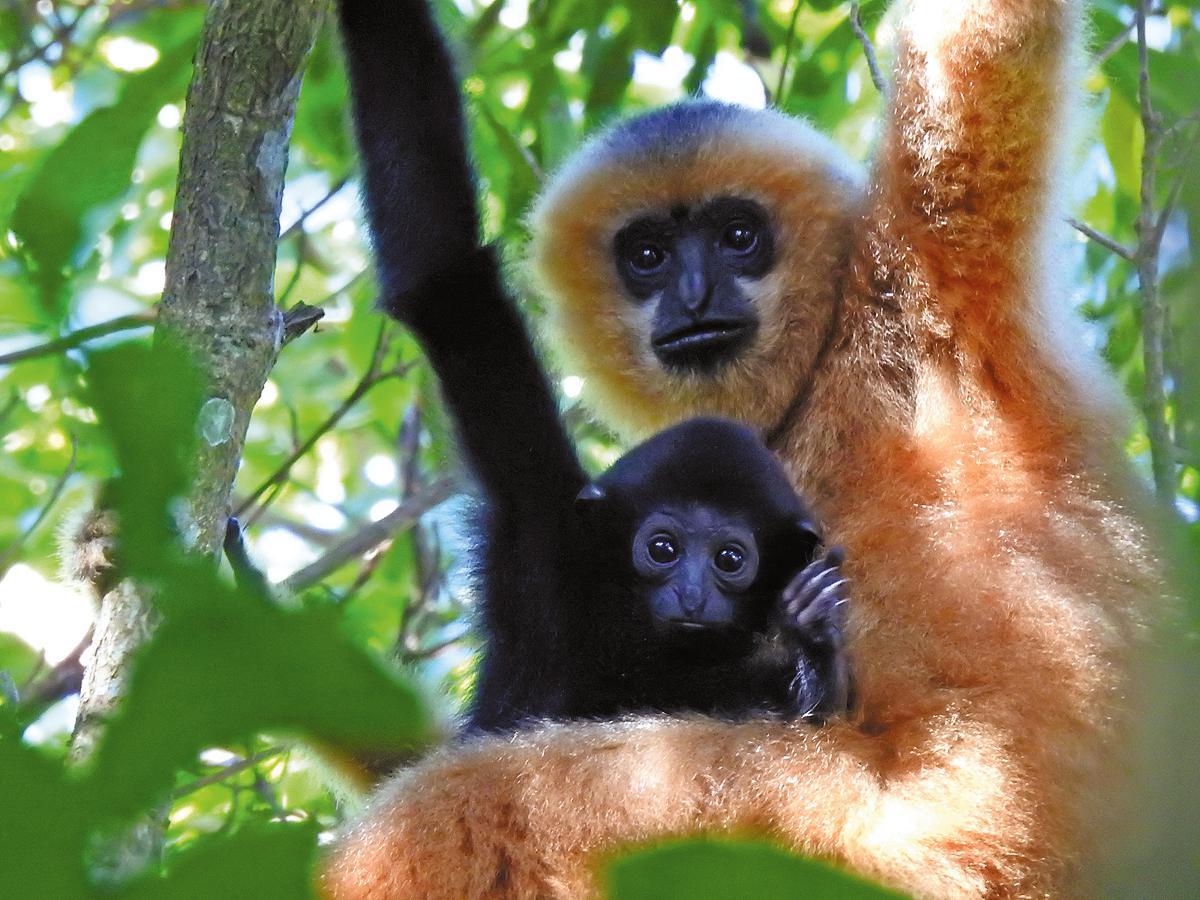Habitat, nutrition, genetics and extreme events can threaten species' recovery

In the heart of the lush Hainan Tropical Rainforest National Park dwells the Hainan black-crested gibbon (Nomascus hainanus). Also known as the Hainan gibbon, it is the world's rarest primate species.
Only 42 individuals remain, a single struggling population clinging to existence within the park's Bawangling area. The International Union for Conservation of Nature classifies them as critically endangered.
For decades, conservationists have strived to bolster their numbers, battling habitat loss and low genetic diversity. A team led by professor Fan Pengfei from the School of Life Sciences at Sun Yatsen University in Guangzhou, Guangdong province, in collaboration with researchers from home and abroad, recently published a paper in Science Advances, an open access multidisciplinary journal.
READ MORE: Rainforest brings gibbons back from edge of extinction
Titled "Science-based suggestions to save the world's rarest primate species Nomascus hainanus", it offers a fresh perspective on the Hainan gibbon's situation and a glimmer of hope for the species' future.
Fan and his team believe that despite the gibbons' dwindling numbers, the quality of their current habitat is surprisingly not poor.
Instead of focusing solely on improving the existing environment, they argue that the priority should be expanding the gibbons' accessible habitat.
They suggest building habitat corridors to rapidly increase the habitat available to the gibbons, a vital step in mitigating the chances of inbreeding — a significant threat given their low genetic diversity.
The team emphasizes that capturing wild gibbons to establish a captive breeding program should be approached with extreme caution. Such an action could diminish the already limited genetic diversity of the population, exacerbating the risk of inbreeding depression — the reduced survival and fertility of offspring from related individuals.
Their recommendations are rooted in robust analysis of years of data.
"The protection of biodiversity is one of humanity's core tasks," Fan told China Daily. "Saving critically endangered species with tiny populations is a key, yet extremely challenging, aspect of biodiversity conservation, and there are few successful cases."
He explained that when a population falls below a certain threshold, it enters an extinction vortex, where random events such as fluctuations in population size, environmental instability and genetic drift — change in gene variant frequencies in a population from generation to generation that occurs due to chance events — continually threaten its survival.
Habitat degradation and accompanied nutritional deprivation, genetic issues such as inbreeding depression and genetic bottlenecks, and extreme events like severe weather can accelerate extinction or impede population recovery.
In such dire circumstances, human intervention, such as habitat restoration and captive breeding, becomes essential, Fan said.
"But these interventions must be based on solid scientific evidence," he added. "Otherwise, significant resources may be wasted on inefficient or ineffective conservation efforts, and may even have a negative impact on the species."
The Hainan gibbon, endemic to South China's Hainan Island, once thrived throughout the province. As recently as the 1950s, estimates placed their population at around 2,000. But habitat loss and rampant poaching caused a drastic decline, leaving only two family groups, a mere 13 individuals, by 2003.
While conservation efforts have gained traction in the past two decades, leading to a slight population increase, Fan said, the species remains trapped in the peril of a small, vulnerable population.
After the establishment of the national park in October 2020, it designated the Hainan gibbon as its flagship species, channeling significant conservation funding toward its protection and habitat restoration.
However, the suitability of the population's existing habitat and its genetic status had not been adequately assessed.
"As a result, habitat restoration and captive breeding programs targeting at the Hainan gibbon have lacked a solid scientific foundation," Fan said.
From March 2021 to December 2022, Fan's team, comprising three of his students and several local forest rangers, successfully habituated two Hainan gibbon family groups to human presence. This allowed the gibbons to exhibit their natural behaviors unperturbed by the observers.
They conducted year-round behavioral observations and collected the largest behavioral dataset on the species to date.
Coupled with analyses of the macronutrient composition of their food plants, the team estimated the gibbons' annual energy intake. This marked the first quantitative assessment of energy intake in wild gibbons.
By comparing their data with captive southern yellow-cheeked crested gibbons that were provided with ample food and other free-feeding captive primates, the researchers found that wild Hainan gibbons had relatively higher energy intakes.
"This suggests that the wild Hainan gibbons are able to obtain sufficient energy from their habitat to meet their needs," Fan said.
The research team organized nearly two decades of population monitoring and estimated crucial breeding parameters, namely female reproductive intervals and male dispersal age.
Comparing these parameters with those of other gibbon species, they discovered that Hainan gibbons have relatively short reproductive intervals and earlier male dispersal ages, indicating a healthy breeding status.
ALSO READ: World's rarest primate grabs a survival lifeline in jungle
Finally, the team constructed a genetic dataset of the existing Hainan gibbon population, including 18 of the 21 adults.
The results revealed that while the gibbon's genetic diversity remains significantly lower than historical levels, the coefficient of relatedness between adult males and females in newly formed family groups is increasing. This suggests that the population faces a high risk of inbreeding.
"Because of these data and analysis, we think our suggestions are solid and practical," Fan said.
"We will continue to monitor population dynamics and investigate energy intake of other groups of the Hainan gibbons, especially those living in secondary forests. Hopefully, our research and conservation efforts can save the species from extinction."
chenliang@chinadaily.com.cn


